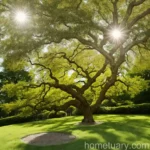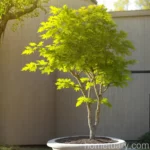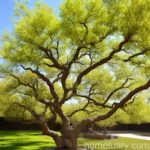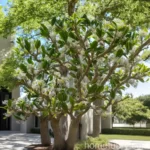Downy Oak (Quercus pubescens var. crispata): A Comprehensive Guide
Downy oak (Quercus pubescens var. crispata) is an intriguing sub-variety of the Quercus pubescens species, a common oak tree found in Europe and parts of Asia. Known for its unique crispate leaves, downy oak has garnered attention for its cultural, ecological, and horticultural significance. In this comprehensive guide, we will explore the key characteristics, ecological importance, cultural uses, cultivation requirements, and propagation techniques of downy oak, along with insights from expert botanists and interesting fun facts.
What is Downy Oak (Quercus pubescens var. crispata)?
Before diving into the details, let’s start by understanding the basic characteristics and taxonomy of downy oak.
Taxonomy
- Kingdom: Plantae
- Order: Fagales
- Family: Fagaceae
- Genus: Quercus
- Species: Quercus pubescens
- Variety: Quercus pubescens var. crispata
Characteristics
- Leaf Type: Deciduous
- Leaf Arrangement: Alternate
- Leaf Shape: Crispate, with deep, irregular lobes
- Bark: Dark and furrowed
- Flower: Catkins
- Fruit: Acorns
Habitat
Downy oak is native to Southern and Central Europe, thriving in a variety of habitats, including deciduous forests, mixed woodlands, and open grassy areas. It is often found growing on dry, acidic, and well-drained soils in hilly or mountainous regions.
Distribution
Quercus pubescens var. crispata is primarily distributed in countries such as Italy, France, Switzerland, Croatia, Greece, and Albania, among others.
Now that we have a basic understanding of the plant, let’s delve deeper into its various aspects.
Key Takeaways of Downy Oak (Quercus pubescens var. crispata)
To provide a comprehensive understanding of downy oak, let’s explore various aspects that are crucial for its cultivation and conservation.
Culture
Understanding the cultural significance and traditional uses of downy oak is essential for appreciating its role in human history and ecosystem management.
Traditional Uses
- Timber: Downy oak wood is highly valued for its strength and durability, making it a preferred choice for furniture, flooring, and construction.
- Tannin Production: The bark of downy oak contains tannins, which have historically been used in tanning leather.
Ecological Importance
Habitat Provider
Downy oak serves as a vital component of forest ecosystems, providing habitat and food for numerous species of wildlife, including birds, insects, and mammals.
Soil Stabilization
The deep roots of downy oak help prevent soil erosion, making it an important species for stabilizing slopes and hilly terrains.
Cultivation
When cultivating downy oak, several factors need to be considered, including water requirements, sunlight exposure, fertilizer needs, soil preferences, and pruning techniques.
Propagation
The propagation of downy oak can be achieved through various methods such as seed germination, stem cuttings, and grafting.
Common Diseases and Pests
Like other plant species, downy oak is susceptible to certain diseases and pests that can affect its health and vigor.
Conservation Status
Given its ecological importance and cultural value, understanding the conservation status of downy oak and the threats it faces is crucial for its preservation.
Now, let’s delve into each of these aspects in detail, providing insights and practical tips for growing and appreciating downy oak in various contexts.
Cultivation
Cultivating downy oak in a home garden or as part of a landscape requires an understanding of its specific requirements in terms of water, sunlight, fertilizer, and soil.
Water
- Young Trees: Adequate watering is essential for establishing young downy oak trees. Regular watering, especially during dry spells, is recommended to promote healthy root development.
- Mature Trees: Once established, downy oak is known for its drought tolerance and can generally thrive without extensive irrigation, particularly in its native habitats.
Sunlight
Downy oak thrives in full sun to partial shade, making it adaptable to a wide range of light conditions. However, it typically performs best when exposed to ample sunlight.
Fertilizer
In general, downy oak does not require regular fertilization if grown in a natural habitat or a well-fertilized garden setting. However, for trees growing in poor soil conditions, a balanced fertilizer application in early spring can promote healthy growth.
Soil
- Acidity: Downy oak prefers acidic to neutral soils and may struggle in highly alkaline conditions.
- Drainage: Well-drained soils are critical for preventing waterlogged conditions, which can be detrimental to the health of the tree.
Pruning
Minimal pruning is typically needed for downy oak, and major pruning should be avoided, especially during the growing season. Pruning to remove dead or damaged branches can be conducted during the dormant season.
Propagation
Propagation of downy oak can be achieved through several methods, including seeds, stem cuttings, and grafting.
Seed Propagation
- Gather acorns from healthy parent trees.
- Cold stratify the acorns for several weeks to simulate winter conditions.
- Plant the acorns in well-draining soil in a sunny location in the fall.
Stem Cuttings
- Take semi-hardwood stem cuttings in late summer or early fall.
- Place the cuttings in a well-draining propagation mix and keep them consistently moist.
- Roots should develop over several months, and the new plants can be transplanted into larger containers or directly into the garden.
Grafting
- Grafting can be a more reliable method for producing clones of specific downy oak varieties.
- Techniques such as whip grafting or side veneer grafting can be employed for successful propagation.
Common Diseases
While downy oak is generally resilient, it can be susceptible to certain diseases that may impact its overall health and growth.
Oak Wilt
Oak wilt, caused by the fungus Ceratocystis fagacearum, is a serious disease that affects various oak species, including downy oak. It can result in wilting and rapid defoliation of infected trees, often leading to mortality.
Powdery Mildew
Powdery mildew, caused by various fungal species, can affect the foliage of downy oak, leading to a powdery white growth on the leaves.
Phytophthora Root Rot
This soil-borne pathogen can cause root rot in downy oak, leading to decline and eventual death of the tree.
Bacterial Leaf Scorch
Bacterial leaf scorch, caused by the bacterium Xylella fastidiosa, can result in the browning and necrosis of leaf margins, eventually leading to dieback.
Common Pests
Gypsy Moth (Lymantria dispar)
The larvae of the gypsy moth are known to feed on the foliage of downy oak, potentially causing extensive defoliation during outbreaks.
Oak Leafminers
The larvae of various leafminer moths can create unsightly tunnels within the leaves of downy oak trees, impacting their aesthetic appeal.
Botanist’s Tips for Downy Oak Care
To further enhance our understanding of downy oak and its care, let’s explore some expert insights and tips from experienced botanists and arborists.
Expert Tip 1: Soil Testing
Before planting downy oak, it is essential to conduct a soil test to assess its pH and nutrient levels. This information can guide soil amendments to create an ideal growing environment for the tree.
Expert Tip 2: Mulching
Applying a layer of organic mulch around the base of the tree can help retain soil moisture, regulate soil temperature, and suppress competing vegetation.
Expert Tip 3: Observation and Pruning
Regular observation of the tree’s canopy can help identify any dead or diseased branches that may require pruning. Prompt removal of such branches can promote overall tree health.
Fun Facts about Downy Oak
Uncovering interesting and lesser-known aspects of downy oak can foster a deeper appreciation for this remarkable species.
- Ancient Heritage: Downy oak has a long history of cultural and ecological significance, with some trees estimated to be several hundred years old.
- Acorn Production: Downy oak trees are known for their prolific acorn production, which provides a vital food source for numerous wildlife species.
- Fall Foliage: In autumn, the foliage of downy oak can exhibit striking colors, ranging from golden yellows to rich browns.
Links to External Resources
For further exploration of downy oak and related topics, the following external resources provide valuable information and insights:
- The Morton Arboretum – Downy Oak
- Royal Botanic Gardens, Kew – Quercus pubescens information
- U.S. Forest Service – Oak Wilt Information
In conclusion, downy oak (Quercus pubescens var. crispata) stands out as a captivating species with its unique foliage, ecological importance, and cultural relevance. By gaining a comprehensive understanding of its characteristics, cultivation needs, and conservation status, we can better appreciate and contribute to the preservation of this remarkable tree.
Through this guide, we’ve aimed to provide a thorough exploration of downy oak, shedding light on its various facets while offering practical insights and expert recommendations for its care and conservation.
Keywords: Quercus pubescens var. crispata, Downy oak variety crispata, Quercus pubescens foliage, Downy oak leaves, Crispate downy oak, Quercus pubescens characteristics, Downy oak tree, Quercus pubescens varieties, Crispate leaves of Quercus pubescens, Downy oak description, Quercus pubescens variety crispata features, Downy oak habitat, Quercus pubescens var. crispata taxonomy, Crispate foliage of downy oak, Quercus pubescens var. crispata growth, Downy oak distribution, Quercus pubescens variety crispata appearance, Crispate leaves of Quercus pubescens tree, Downy oak species information, Quercus pubescens var. crispata characteristics, Downy oak facts, Quercus pubescens variety crispata traits, Crispate downy oak morphology, Quercus pubescens var. crispata ecology, Downy oak uses, Quercus pubescens foliage features, Crispate leaves of downy oak tree, Downy oak conservation status, Quercus pubescens var. crispata growth habits, Downy oak adaptation, Quercus pubescens variety crispata distribution, Crispate characteristics of Quercus pubescens, Downy oak taxonomy, Quercus pubescens var. crispata habitat, Crispate leaves of downy oak description, Downy oak var. crispata ecology, Quercus pubescens variety crispata traits, Crispate downy oak morphology, Quercus pubescens var. crispata facts, Downy oak variety crispata information, Quercus pubescens foliage features, Crispate leaves of downy oak tree, Downy oak uses, Quercus pubescens var. crispata growth habits, Downy oak adaptation, Quercus pubescens variety crispata distribution, Crispate characteristics of Quercus pubescens, Downy oak var. crispata habitat, Quercus pubescens variety crispata conservation status, Crispate leaves of downy oak var. crispata description















